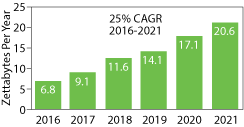Automotive Radar and Wireless Communications
Future connected and autonomous cars will be equipped with a wide array of communications and sensors. One of the most significant applications is radar for vehicle detection, cruise control and obstacle avoidance (see Figure 2). All of the automotive radar frequency bands are in the mmWave spectrum, at 24, 77 and 79 GHz. It is likely that manufacturers will not require many mmWave coaxial cables and connectors within the radar assemblies themselves, but the design, testing, installation and maintenance of these systems will require metrology-grade coaxial cables and connectors.

Figure 2 Future cars will have several automotive radar systems operating at mmWave frequencies. Source: Robert Heath.2
The next generation of cars will also be equipped with wireless communications as standalone features or augmenting user equipment as 5G hotspots. 5G machine-to-machine (M2M) communications will likely account for enhanced autonomous vehicle coordination and also vehicle-to-infrastructure (V2I) communications. All of these applications will require mmWave coaxial cables and connectors within the modules and to facilitate communications between modules.
mmWave ICs
The above applications and other SATCOM, aerospace and military applications require MMICs operating at mmWave frequencies. These MMICs and the complex modules housing them necessitate rigorous testing, calibration and validation before being employed in mission-critical applications. Some of these applications, such as mmWave imaging, radar and chip-to-chip communications, may operate well above 100 GHz and require 1 mm and smaller coaxial connectors. Currently, 0.8 mm coaxial cables are capable of performing to 145 GHz.
Testing systems that operate above a few tens of GHz will produce harmonics into the hundreds of GHz. For testing of power amplifiers, receivers, transceivers, mixers and modulation, mmWave testing at multiples of the base frequency is necessary to characterize performance. Hence, the future may require coaxial cable assemblies that operate to frequencies well above the range of currently available assemblies.
Automated Testing
To keep costs low, many mmWave devices will use automated testing in facilities that demand rugged, reliable, consistent and high performance interconnects. Traditional mmWave coaxial cables and connectors for test and measurement have been precision cables, which are not particularly rugged nor do they perform well under stress and strain. Automated test systems are often subject to vibration, shock, repeated flexure and many mate-unmate cycles, which many mmWave connectors will not withstand and maintain consistent performance and calibration. More rugged, metrology-grade coaxial assemblies will be needed in much higher volume, at prices and availability more accessible than available today.

Figure 3 Cisco predicts global data center traffic will exceed 20 zettabytes per year in 2021.3
High Speed Data
It is no secret that data speeds for military, government and communications systems are increasing to meet the demands of new applications and provide inter-system communication. The current transition for high speed internet traffic is from 40G to 100G Ethernet, and 400G and 800G are in experimental and demonstration platforms. The massive increase in throughput capability for communication channels is based on a need to send more data, faster and less expensively (see Figure 3).
Also, digital integration into traditional, RF-only systems is increasing, to enable advanced phased arrays, massive MIMO, complex beamforming, upgraded modulation and low-probability-of-detection/low-probability-of-intercept radar. Architectures such as full-digital beamforming, software-defined radio (SDR) and cognitive radio will require much higher speed digital communications between subsystems and modules, while meeting military standards for reliability and precision. Though fiber-optic technologies are used extensively for Ethernet, there are still requirements for short runs, design/prototyping, installation and maintenance, which will require the use of mmWave coaxial assemblies.
